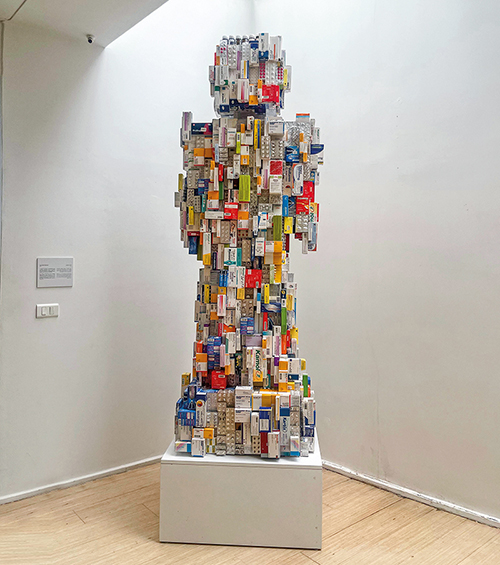|
|
Best First Solo Exhibitor - 2025
Best First Solo Exhibitor - 2025
|
|
Manar Ali Hassan
Manar Ali Hassan
|
|
 |
|
Painful Body Stories. |
|
Exhibited at Galerie Janine Rubeiz |
|
|
A powerful unflinching look at life with chronic pain, not as a metaphor, but as a lived, embodied truth. This deeply personal exhibition presented a collective portrait of women, including the artist herself, all living with fibromyalgia, a condition marked by widespread and often invisible suffering.
The exhibition spanned a range of media: suspended textile works, black-and-white photography, sculptural installations built from pill containers, and two poignant video pieces. Each work is both testimony and tribute—an effort to make sense of pain that defies clarity. Rather than documenting illness, the artist visualizes its impact on identity, relationships, and the body itself.
The centerpiece, The Sacred Magician, towers over the gallery at over two meters. Composed entirely of used medication boxes, it critiques the pharmaceutical industry’s commodification of suffering, while also functioning as a shrine to endurance. It’s a haunting presence—part memorial, part protest.
In Imprints of Constriction, ghostly figures emerge through layers of ink, hand-stitching, and translucent fabric. These bodies appear fragmented. They are twisted, absent of limbs, floating like shrouds. The abstraction is intentional: it evokes the instability of the self under the strain of relentless physical pain.
In Burning Traces, blurred photographs of passive bodies capture not only discomfort, but the mental fog and isolation that often accompany illness. The lack of sharp focus is not a flaw but a strategy, as it reflects the way pain distorts perception, memory, and time.
The artist doesn’t ask for sympathy. She offers intimacy. Her work doesn’t translate pain, it makes space for it, in all its confusion and defiance. The exhibition is not only a reflection on chronic illness, but a meditation on dignity and survival. It gives voice to what is usually silent and shape to what is rarely seen. In doing so, it reminds us that suffering, though often private, is never without meaning, and that art can carry the weight of it, if only for a while.
|
|
|
|
|
|
|
|
|
© 2025 by InfoPro sal. All Rights Reserved
|
|
|
|